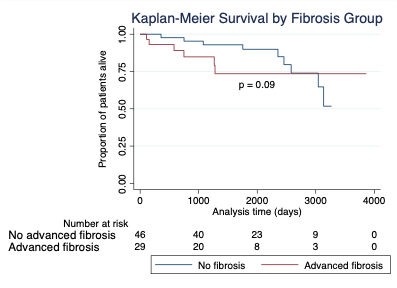Kidney Transplant Alone Recipients with Advanced Liver Disease Have Similar Outcomes to Those without Advanced Liver Disease
Icahn School of Medicine at Mount Sinai, New York, NY
Meeting: 2022 American Transplant Congress
Abstract number: 125
Keywords: Fibrosis, Hepatitis C, Kidney transplantation, Liver cirrhosis
Topic: Clinical Science » Liver » 53 - Liver: Cirrhosis - Portal Hypertension and Other Complications
Session Information
Session Name: Cirrhosis: Complications, Portal Hypertension and Renal Management
Session Type: Rapid Fire Oral Abstract
Date: Sunday, June 5, 2022
Session Time: 5:30pm-7:00pm
 Presentation Time: 6:00pm-6:10pm
Presentation Time: 6:00pm-6:10pm
Location: Hynes Room 311
*Purpose: The prevalence of concomitant liver disease (CLD) in patients with ESRD is reported to be 7-40%. Safety of kidney transplant alone (KTA) in those with advanced liver disease (ALD) is controversial. KDIGO guidelines recommend KTA consideration in compensated cirrhosis based on few small studies. We compare outcomes in KTA patients with ALD to KTA patients with non-ALD.
*Methods: Retrospective analysis of all KTA patients at our center from 1/2012-12/2020 was performed. KTA patients with CLD were identified. ALD and cirrhosis status were determined by clinical criteria and if available, liver biopsy. Matched cohort analysis was performed using age, time on hemodialysis (HD), sex, and ethnicity. Primary outcome was mortality and secondary outcomes were serious infection (requiring intravenous antibiotics), allograft rejection, allograft failure, and liver decompensation.
*Results: Over 8 years 1741 KTAs were performed and 150 (8.6%) recipients had CLD (Table.1). Of these 29 (19%) patients with ALD at time of KTA and 27/29 (93%) had compensated cirrhosis, with mean MELD 21.8 (SD +/- 3.8). The 1-, 3- and 5-year survival rates were 95.5%, 89.8% and 79.5% respectively. KTA patients without ALD (n=46) were selected as a matched cohort. Kaplan-Meier survival analysis showed similar outcomes between KTA with CLD subgroups (p=.09). On matched cohort analysis, 6 (21%) cases died vs 9 (20%) controls (p=.9). Mean time to death was 1645 (SD +/- 939) days in cases vs 689 (+/- 514) days in controls (p=.06). Secondary outcomes were similar between the 2 groups: serious infection 21% vs 28% (p=.51); allograft rejection 14% vs 13%, (p=.55); allograft failure 14% vs 4.3% (p=.2); Liver decompensation 14% vs 0 (p=.6), mostly due to ascites (3/4), but also esophageal varices and hepatocellular carcinoma (causing death in 1 patient).
*Conclusions: This is one of the largest single-center studies comparing outcomes in KTA patients with and without ALD. KTA patients with CLD had excellent outcomes, with similar patient, graft, infection and liver decompensation outcomes between those with ALD and those without. This supports the practice of KTA in patients with CLD, even with advanced fibrosis.
| Male (%) | 81 |
| African American (%) | 50 |
| Mean Age (years) | 65 |
| HCV as LD etiology (%) | 72 |
| Mean follow up in days (+/- SD) | 1807 (+/- 960) |
| Transjugular liver biopsy available (%) | 41 |
| Mean hepatic venous pressure gradient in mmHg (+/- SD) | 6.2 (+/-3.2) |
To cite this abstract in AMA style:
Nathani RR, Rutledge SM, Villarroel C, Shapiro R, Im GY. Kidney Transplant Alone Recipients with Advanced Liver Disease Have Similar Outcomes to Those without Advanced Liver Disease [abstract]. Am J Transplant. 2022; 22 (suppl 3). https://atcmeetingabstracts.com/abstract/kidney-transplant-alone-recipients-with-advanced-liver-disease-have-similar-outcomes-to-those-without-advanced-liver-disease/. Accessed December 29, 2025.« Back to 2022 American Transplant Congress

